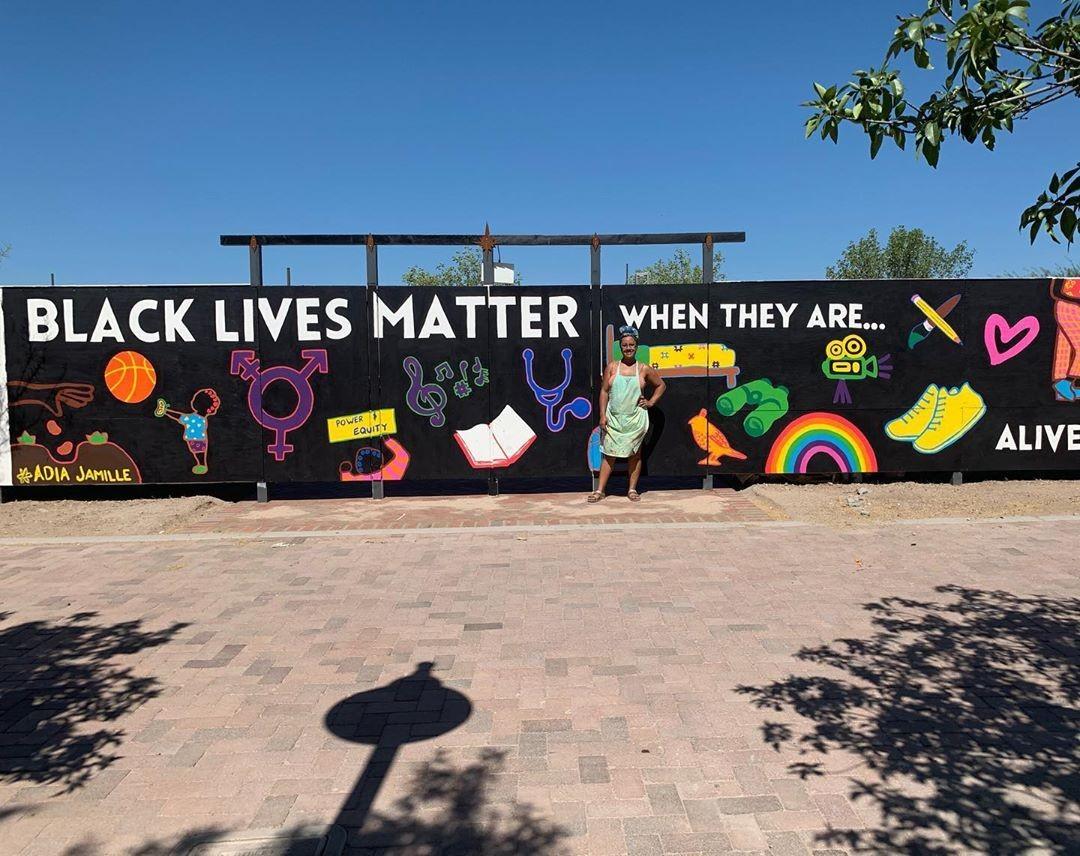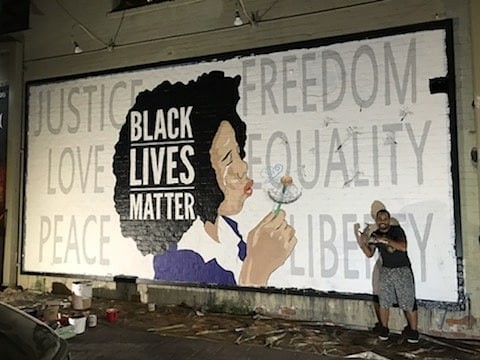Tucson is a mural town. Impressive paintings grace the sides of buildings, decorate downtown and are staples of both the city and Tucsonans’ Instagram feeds.
In the past few weeks, however, a few new murals have appeared around town. These pieces, which are the result of a collaborative art project organized by Tucson muralist Joe Pagac, all come with a strong and clear message: Black lives matter.
This June, Pagac collaborated with Tucson artists, including Robbie Lee Harris, Adia Jamille and To-ree-nee Wolf to add murals to blank walls around the city. The murals, all of which were inspired by and seek to show support of the Black Lives Matter movement, are up now.
Pagac, who has painted many murals around Tucson, was inspired to develop this project after the killing of George Floyd and the surge of worldwide outcry, protests and support for the Black Lives Matter movement.
“Generally, I have a rule of not using my art politically,” Pagac said. “I think so much in the political sphere can be gray. [But] this feels very black and white to me. I can’t see any argument against equality for everyone and for everyone being treated in a way that’s caring and just.”
Pagac talked to friends and activists who advised him to use his platform as an artist to amplify some Black voices in the community. On June 1, Pagac put out a call on Facebook for Black artists who were interested in painting. On June 5, he created a GoFundMe to raise money for the project.
As of June 26, the GoFundMe has raised over $4,000 in support of the project.
“That money is going to go to materials and then all the rest will go to artists who are painting it,” Pagac said.
Besides gaining monetary support from the community, the artists have received positive feedback for the murals themselves.
“Not only are [the artists] getting their work out there, but they’re getting a bunch of press,” Pagac said. “Some of them now are getting jobs off of the murals that have gone up, which is super cool, but they’re also getting paid for it. Which, I think, helps carry that momentum forward with them getting their art out. It’s been a super positive experience for everyone involved so far.”
The first mural to go up was developed and designed by Harris, whose work usually focused on painted portraits. His mural features a young Black woman blowing the seeds off a dandelion flower. She’s surrounded by words such as “justice,” “freedom” and “equality.” Harris’s mural, which is 24 feet long and 12 feet high, was painted in one night by Harris and Pegac and is up on one of the walls of the Rialto Theatre in Downtown Tucson.
Harris hopes that passersby who see the mural will gain an understanding not only of the hopes of the movement, but also of themselves.
“The innocence behind portrays a mirror effect. When you look at the mural, you get an inner reveal of who you are,” Harris said. “I think I designed something that’s simple and innocent enough [that] if you’re offended by anything on that mural … something’s wrong with you. Hopefully that triggers a guilt trip, to look at that image and say anything negative. Hopefully it gives some hope and some positivity and the actual want for change.”
The feedback that Harris has received on his work so far indicates that the mural is indeed having that effect.
“I got several messages from people saying that they saw it and that it felt like a call to action, that they felt that they needed to do something after seeing it,” Harris said. “I like that effect that art has, that it triggers emotions in people. I hope that [the mural] triggers the right ones.”
One of the next murals to go up was designed and painted by Tucson fiber artist Jamille, who believes that art — particularly protest art — can connect with those who aren’t engaging with the movement or the message otherwise.
“[Art is] something that can speak to people who aren’t listening to other forms,” Jamille said. “They’re not reading books. They’re not watching documentaries. They’re not attending protests. But they’re walking down the street and they see these murals. I think it’s a way for people to be exposed to things, more or less, on their own terms.”
Jamille’s mural was painted at Mercado San Agustine Annex, which is a cluster of local, small businesses on the west side of I-10. Her mural is 6 feet high and 33 feet wide, according to Jamille. It features bright, colorful illustrations on a black background and the words, “Black lives matter when they are alive.”
Jamille had a very specific message in mind when she designed her mural.
“I wanted to focus on the fact that we need to care about black lives before they become hashtags,” Jamille said. “Black people live full lives before these things happen to them. If we did, they wouldn’t become hashtags.”
RELATED: March 4 Justice Tucson’s Juneteenth: Institutionalized, history and the present day
Many of the smaller illustrations in Jamille’s mural were calls to specific Black people who have been victims of police brutality or specific issues that Black Americans face.
“The bed is for Breonna Taylor,” Jamille said. “The birdwatching is for [Christian Cooper]. The little girl is about how Black children don’t just get to be Black children.”
In addition to these images, the mural also featured the symbol representative of transgender identity, in reference to the many Black transgender women who are victims of systemic violence, and an illustration of a pregnant woman, in reference to the poor health care that Black women receive during childbirth.
“I was nervous because I wasn’t sure that people would get what I was saying,” Jamille said. “But every time I showed it to somebody, they knew exactly what I was saying.”

Jamille, whose main work is in fiber art and embroidery, also had experience with illustration and photography. She feels that art has the unique power to preserve, especially in moments like this one.
“While [art] is open for interpretation, it can’t be manipulated,” Jamille said. “It is what it is. When you see paintings from the moment, you can tell what people were feeling. You can tell what they were fighting for or against. I think art is really beautiful because it preserves what’s happening.”
Ultimately, all of the artists hope the murals will have a positive impact on the people who see them and the way they think of the Black Lives Matter movement.
“[Art] tends to be a more positive and uplifting way of reaching people. … You’re simultaneously putting out a message and creating beauty in the world,” Pagac said.
He said he hopes the murals and the public’s response also reflect well on the culture of Tucson as a whole.
“Tucson is a place that is supportive of these views, is embracing of these views and hopefully a place where those views can take their hold and keep their hold and continue to grow,” Pagac said. “The fact that those murals go up and stay up and don’t get vandalized and are photographed and visited helps to show that our community is, in some ways, a safe place for this type of thought process.”
Harris and Jamille were both hopeful that the current widespread protests, outrage, support and calls to action were reflective of the fact that this movement could be more successful in gaining Black rights than protests in the past have been.
“Sadly, this is a repeat of history,” Harris said. “I’m experiencing things now that I read about in history books. It’s like, man, we did not learn from these mistakes. There’s a lot of work that still needs to be done. I’m thrilled to be on what I feel is the right side of that but I feel that change is long overdue.”
For Jamille, hope for the future is accompanied by an understanding of how much individuals will need to change the way they think and live.
“As we watch the world explode right now, hopefully it’s gonna wake up people to finally say, ‘I can’t just sit here and be quiet,’ and make better choices in how they vote, how they interact with people and with the media they consume. I don’t know if anything’s going to change but I hope it does,” Jamille said. “It feels different now. I see a lot more people who were just existing who have decided that they want to engage.”
Besides widespread systematic change, Harris is also hopeful that the movement and advancement of racial equality will render his mural unnecessary.
“My ideal future … is where a mural like mine doesn’t make sense,” Harris said. “Where a mural of a young girl with words ‘liberty’ and ‘freedom’ and ‘justice’ behind her is far-fetched to understand because it exists. The idea that we have to tell people that Black lives matter would be a foreign concept because we know that Black lives matter.”
Harris is hopeful that this future could be a reality.
“I think we can do this. I think we can end our injustice in our generation,” Harris said. “We can fix what is ultimately our broken system. I challenge us as a people to fix our injustice and our system that we have. Let’s get together and let’s get this right, finally.”
Follow Katie Beauford on Twitter















